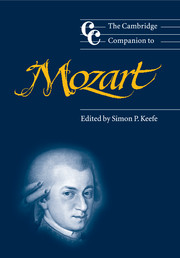Book contents
- Frontmatter
- Introduction
- Part I Mozart in context
- Part II The works
- 5 The keyboard music
- 6 The concertos in aesthetic and stylistic context
- 7 The orchestral music
- 8 Mozart's chamber music
- 9 Mozart as a vocal composer
- 10 The opere buffe
- 11 Mozart and opera seria
- 12 Mozart's German operas
- Part III Reception
- Part IV Performance
- Notes
- Selected further reading
- General index
- Index of Mozart’s works
10 - The opere buffe
from Part II - The works
Published online by Cambridge University Press: 28 September 2011
- Frontmatter
- Introduction
- Part I Mozart in context
- Part II The works
- 5 The keyboard music
- 6 The concertos in aesthetic and stylistic context
- 7 The orchestral music
- 8 Mozart's chamber music
- 9 Mozart as a vocal composer
- 10 The opere buffe
- 11 Mozart and opera seria
- 12 Mozart's German operas
- Part III Reception
- Part IV Performance
- Notes
- Selected further reading
- General index
- Index of Mozart’s works
Summary
In the history and criticism of Mozart's opere buffe, all roads lead back to Carlo Goldoni. The comic works of the Venetian lawyer-turned-playwright influence every Mozart opera buffa in one way or another. Mozart's first, La finta semplice, comes from a Goldoni libretto (by way of Marco Coltellini); his last, Don Giovanni and Così fan tutte, use topics and language that Goldoni had treated earlier; and all of them divide the characters into the Goldonian parti buffe, parti di mezzo carattere and parti serie. The pressing question about Mozart's opera buffa repertory, then, is not whether Goldoni influenced Mozart, but how he did so.
The difficulty in striking a consensus about Goldoni's influence on Mozart comes largely from tensions inherent in the Goldonian repertory itself. In the eighteenth century, as today, Goldoni's reform of comedy was generally understood in one of two contrasting ways: as a technical achievement, or as an ethical one. According to the former view, Goldoni did not reject the commedia dell'arte – the often ribald improvisations of professional actors which had been the basis of Italian popular comedy for some two centuries – but rather improved on it. Replacing improvised scenarios with fully scripted comedies gave him control over pacing and clarified the action. The finest representative of this kind of comedy was also the most famous in the eighteenth century: Il servitore di due padroni (1745), a work that Mozart had hoped to turn into a Singspiel.
- Type
- Chapter
- Information
- The Cambridge Companion to Mozart , pp. 131 - 146Publisher: Cambridge University PressPrint publication year: 2003
- 1
- Cited by

